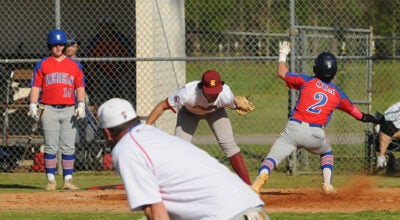Red snapper program is vital
Published 10:44 am Wednesday, September 2, 2015
By David Rainer
Alabama Marine Resources Director Chris Blankenship has a point to make, but the audience he needs to reach is not on the Alabama Gulf Coast.
Alabama’s salt water anglers are well aware of the red snapper story, so Blankenship reached out to what is known as the Washington (D.C.) bubble, where outside information has a hard time gaining attention.
Blankenship came up with a plan for a “show and tell” event that would expose staffers from the offices of U.S. Congressmen and Senators from Alabama, Mississippi, Florida, Louisiana and Texas to exactly what a red snapper fishing trip off the Alabama Gulf Coast is like.
Last week, he pulled that off with great success, utilizing the Gulf Headboat Collaborative Program to accomplish the mission.
“We wanted to show the congressional staffers exactly the condition of our fishery here,” Blankenship said. “I’ve been to Washington four times over the last year-and-a-half to talk about red snapper and the need for changes in federal legislation to give the states more flexibility and to transfer some of that management to the states.
“We can talk about it, but they hear from a lot of people. We wanted them to have the opportunity to come down here personally and see how great our fishery is and what that fishery means to our community. This puts people’s faces and names with a very important issue.”
The reason Blankenship was able to arrange the trip out of Orange Beach on Capt. Randy Boggs’ Reel Surprise outside of the regular red snapper season, is because of a pilot program that has been in effect for the last two years, the aforementioned Gulf Headboat Collaborative (GHC).
The GHC is an exempted fishing permit program for 17 headboats from across the five Gulf states. It essentially takes the amount of fish these headboats have historically caught and holds them out of the recreational quota. These federally permitted boats are allowed to catch those allotted red snapper any time during the year. When the allotment is depleted, no more red snapper can be retained. Each vessel in the program is equipped with a VMS (vessel monitoring system) that tracks its movement via satellite.
“It doesn’t allow them to catch any more fish than in the past,” Blankenship said. “It just allows them to have a business plan and make their quota last throughout the year. The program has worked very well. They have to send Marine Resources an email before they leave dock and send us an email one hour before they reach the dock in the afternoon so we can have an officer inspect their catch.
“We wanted to go out with Capt. Randy Boggs and catch a few red snapper to bring back and cook to really show the people how important this fishery is not only to the charter boats but to the restaurants and other businesses that depend on having access to this great fishery.”
The GHC pilot program was in effect for 2014 and 2015. Despite its success, the program may not be renewed by the Gulf of Mexico Fishery Management Council in time for 2016.
“There is a proposed amendment that would essentially extend that program, but the Gulf Council process is very slow,” Blankenship said. “It looks like in 2016 the headboats will be back in the fishery with all the other charter boats. That program will have a hiatus of at least one year while they work out the extension through the Gulf Council.
“This pilot program is showing that it works on headboats, so the charter boats in Alabama are interested in a similar type program to use a portion of the quota assigned to the charter boats in Alabama.”
Last week, Capt. Boggs set a course to one of his artificial reefs about 30 miles from the mouth of Perdido Pass to provide an example of how good the red snapper fishing is off the Alabama coast.
After a leisurely ride in 2-foot seas, Boggs pulled back the throttles and gave the order to “drop ‘em down.”
“Don’t let it go to the bottom,” he said. ‘That’s where the little fish live. There are fish showing up starting at 35 feet. Give it a count of about five or six and see what happens.”
What happened was a fantastic, frenetic example of snapper fishing in Alabama’s artificial reef zone.
In less than 10 minutes, big red snapper after big red snapper hit the deck. When Boggs gave the order to “keep ‘em up,” there were 24 impressive red snapper caught by the congressional staffers in the fish box.
The crew changed tackle to try to target the smaller vermilion snapper at the next two stops, but all the anglers caught and released were different-sized red snapper.
Trolling on the way back in, a small king mackerel was added to the catch.
“We went to one reef and red snapper just came to the top; there were so many red snapper there,” Blankenship said. “The action was fast and furious with big snapper. The next two places we went had plenty of small red snapper that were 12, 13, 14 inches mixed in with larger fish. It just shows that we really do have a good, mature fishery with good recruitment with a lot of small snapper coming up behind these big ones.
“We really want to be able to manage the fishery for the benefit of the anglers and the resources, and we feel like we can do that better locally than Gulf-wide.”
Blankenship said the congressional staffers were “extremely impressed” by the red snapper fishery off Alabama.
“Even though we talk about how we have plenty of red snapper, it made a real impression for them to go out after the charter season and after the recreational season and see how many red snapper are still on our reefs off the Alabama coast. It gave them an appreciation that the states can do more accurate assessments and better manage that fishery to give our people more access to the fish.
“And they wanted to see the restaurants, marinas and dock stores. They really wanted to see how many businesses rely on tourism and rely on a healthy fishery here in the state of Alabama and rely on continued access to red snapper, the fish that the Alabama Gulf Coast is most known for. The staffers asked some great, probing questions, not only about the recreational fishery but the charter and commercial fishery and how we could manage the different sectors fairly.”
The fishing trip turned out exactly as Blankenship had envisioned.
“It probably could not have turned out any better,” he said. “We were able to catch some very large snapper very quickly on one of our reefs, and then go to some other reefs and catch small snapper mixed in with big ones. Several big snapper came up to the top right off the stern of the boat on one of the well-known public reefs, which just shows you how many snapper are available on those reefs.
“We feel like our fishery is so good because of our reef-building program and partnerships with other agencies. There couldn’t have been a better opportunity to showcase our fishery and to discuss the real issues that need to be solved in Washington to fix the current federal management.”
To top off a great day of fishing, the cleaned red snapper were taken to the Flora-Bama Yacht Club for a sumptuous dinner meal prepared by Chef Chris Sherrill, Sous Chef Haikel Harris and the restaurant staff.
“Chris is a talented chef and was really able to showcase the fish and hospitality of the state of Alabama,” Blankenship said.
“This type of trip shows that we’re not sitting idly by and waiting for something to happen on red snapper,” he said. “We’re working every avenue we can to give our fishermen more access and to give us the ability to sustainably manage the red snapper fishery the way that it needs to be managed.”





